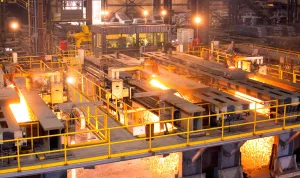Steel Tariffs and Their Impact on Hong Kong’s Market: A Comprehensive Analysis

In recent years, steel tariffs have become a pivotal factor in global trade dynamics, influencing markets far beyond the borders of the nations imposing them. For Hong Kong, a significant player in the steel industry and an essential hub for international trade, understanding how these tariffs affect its market is crucial. This article delves into the multifaceted impact of steel tariffs on Hong Kong’s economy, examining both immediate and long-term consequences.
Understanding Steel Tariffs
Steel tariffs are taxes imposed by governments on imported steel to protect domestic industries from foreign competition. These tariffs can vary in scope and severity, affecting the cost and availability of steel in the markets they target. For Hong Kong, a city with a robust steel industry and extensive import/export activities, these tariffs can have profound implications.
Immediate Impact on Steel Prices
One of the most direct effects of steel tariffs is the increase in steel prices. When tariffs are imposed, the cost of importing steel rises, which can lead to higher prices for steel products within Hong Kong. This price increase can affect various sectors, including construction, manufacturing, and infrastructure development. Projects that rely on steel may face budget overruns or delays due to the increased cost of materials.
Effects on Local Steel Industry
Hong Kong’s local steel manufacturers may experience a mixed impact from steel tariffs. On one hand, higher tariffs on imported steel could create an opportunity for local producers to increase their market share by offering competitive prices. On the other hand, if local manufacturers rely on imported raw materials or components, they might face higher production costs, which could negate the benefits of reduced competition.
Impact on the Construction Sector
Hong Kong’s construction sector is heavily dependent on steel for various applications, including building infrastructure and high-rise buildings. Increased steel prices due to tariffs can lead to higher costs for construction projects. This could result in delayed projects or increased costs for both public and private sector developments, potentially affecting Hong Kong’s real estate market and overall economic growth.
Trade Relations and Supply Chain Disruptions
Steel tariffs can also strain international trade relations and disrupt supply chains. Hong Kong, as a major trading hub, might face challenges in sourcing steel from its traditional suppliers. These disruptions can lead to delays and increased costs for businesses that rely on a steady supply of steel. Furthermore, trade tensions resulting from tariffs can impact Hong Kong’s broader trade relationships and economic stability.
Long-Term Economic Implications
In the long term, the impact of steel tariffs on Hong Kong’s market can influence its economic trajectory. While higher tariffs might protect local industries temporarily, they can also lead to increased production costs and potential retaliatory measures from other countries. This complex interplay can affect Hong Kong’s competitive position in the global market and its economic growth prospects.
Adapting to Steel Tariffs
To mitigate the adverse effects of steel tariffs, businesses and policymakers in Hong Kong can explore several strategies. These include diversifying supply sources, investing in technology to improve steel production efficiency, and advocating for trade policies that support fair competition. By adopting proactive measures, Hong Kong can better navigate the challenges posed by steel tariffs and sustain its economic vitality.
Conclusion
Steel tariffs have a significant impact on Hong Kong’s market, influencing steel prices, local industries, construction projects, and international trade relations. Understanding these effects is crucial for businesses, policymakers, and stakeholders as they navigate the complexities of a globalized economy. By staying informed and adopting adaptive strategies, Hong Kong can continue to thrive amidst the evolving landscape of international trade.



